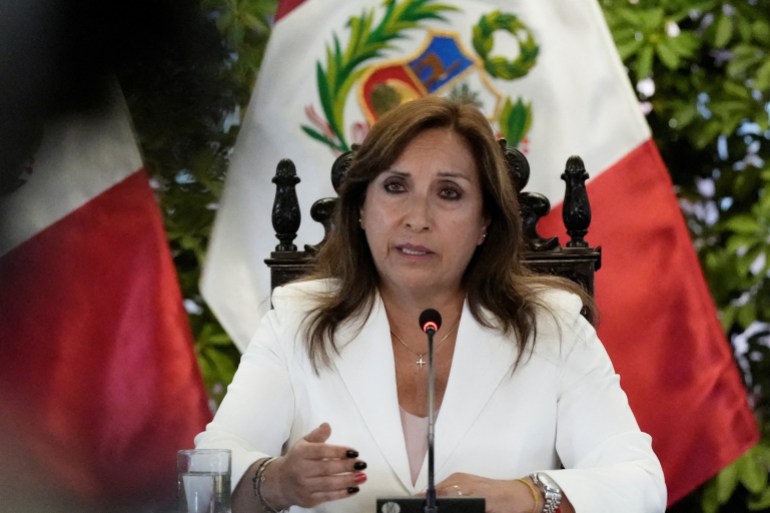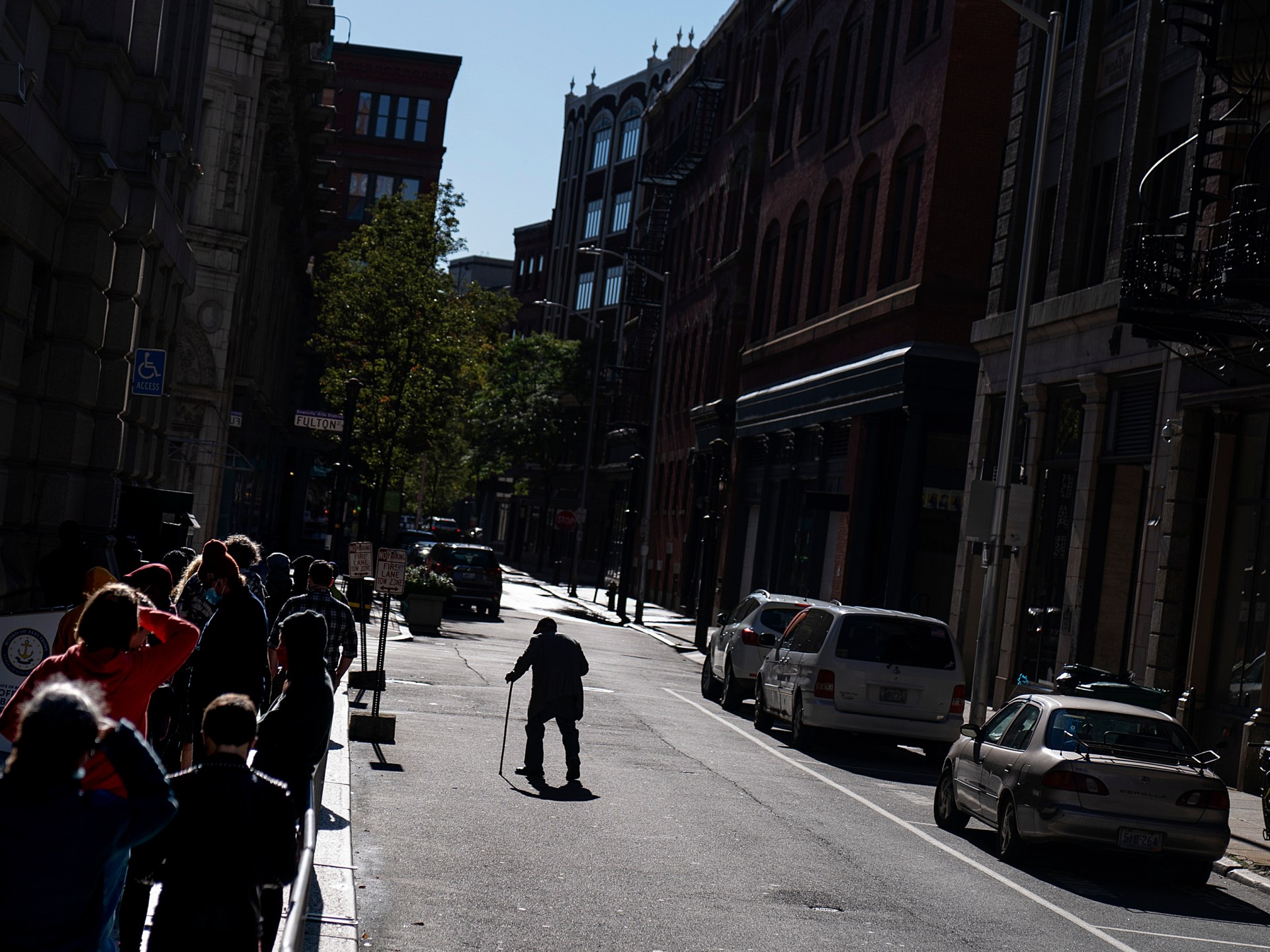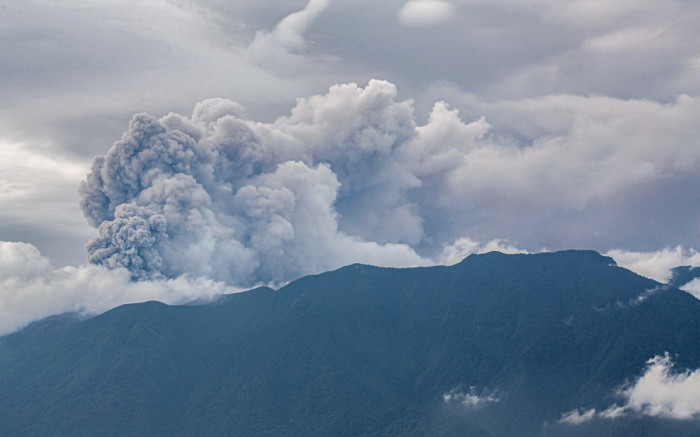
Lima, Peru – Lenin Tamayo strolls up the neoclassical steps of Peru’s Supreme Court, carrying a colorful indigenous shawl over his shoulder. He is very aware of the power of symbolism.
The 23-year-old Peruvian singer has found viral fame in recent months, racking up millions of views Tick tock – thanks to its novel music genre that combines influences from different continents and cultures.
He combines Korean beats, Andean folklore and subversive images and in some cases uses his music to target the government of President Dina Boluarte.
“I want to inspire others,” said Tamayo, who sings in Quechua, an indigenous language spoken by the Incas and still spoken by an estimated 10 million people across South America. “I want love to unite us, to unite our people.”
Tamayo’s music, which gives a Quechua touch to Korean K-Pop music, has been called “Q-Pop”. Every song on his debut album Amaru, released in August, is inspired by Inca mythology. The title itself refers to a mythical double-headed serpent.
During his performances, Tamayo dances extravagantly – with the highly choreographed dance moves of a K-pop star – to the accompaniment of traditional Andean musical instruments such as panpipes and rainsticks.
Although he was born in the capital Lima, Tamayo grew up in the culture of the Andes, the ancestral homeland of the Incas and other indigenous groups.
The only child of Yolanda Pinares, an Andean artist who sings in Spanish and Quechua, Tamayo grew up listening to a wide range of Latin American folk music.
He often waited backstage for his mother while she juggled performing with busking and bartending.
Pinares has integrated Andean tradition into everyday life in Tamayo. She even packed his school lunch box with foods from the Peruvian highlands like “cancha” – roasted corn kernels – and “tarwi”, a legume from the Andes.
But these lunchtime snacks caused a stir among his schoolmates in the capital. This, along with his shy demeanor and atypical appearance – a thin build, bushy eyebrows and pronounced cheekbones – led to bullying.
“I felt this internalized racism,” he said. “I was shy as a boy.”
Music has long been a way for Tamayo to process his struggles. At the age of seven he appeared on stage with his mother for the first time. At the age of 14 he wrote songs for her. He later learned to use social media to promote their work.
But he went his own way when he started writing his own songs at the age of 22.
“I was born on stage,” Tamayo said. “But it was different when I started writing my own songs.”
Tamayo’s music took cues from his mother’s folk-centric sound and incorporated contemporary influences such as the genre-bending style of Spanish singer Rosalía and K-pop icons Girls’ Generation and BTS.
But Tamayo mixes these inspirations with the sounds and rhythms he grew up with. “I wanted to reclaim my identity with my words and my compositions, to explain where I come from.”
This music has struck a chord in the Andes and beyond: He has 5.3 million likes and more than 227,200 followers on TikTok.
Americo Mendoza, founder of the Quechua Initiative on Global Indigeneity at Harvard University, attributed Tamayo’s popularity in part to the fact that Quechua speakers are rarely represented in the media.
“Even though one in 10 people in Peru speak Quechua, they are treated as a minority community, as second-class citizens,” Mendoza said. “This goes back to colonization and was reinforced by the violence against them in the late 20th century.”
Mendoza argued that Tamayo is part of a movement of growing cultural pride, particularly among younger Quechua speakers, who are often the first in their families to move to the cities and study at university.
“Lenin’s story is the story of many young people living in urban spaces and affirming their culture,” he said. “Not just in Peru, but also in Bolivia, Ecuador and beyond. It’s a reminder of how indigenous [peoples] negotiate and adapt their presence and voices on global stages as they defy stereotypes that indigeneity is a thing of the past.”
At the same time, Tamayo also uses music as a tool for political change.

Over the last year, deadly protests have rocked Peru ever since Impeachment proceedings and ousting former leftist President Pedro Castillo, a move that critics call a coup. His vice president, Boluarte, was quickly sworn in to replace him.
However, Castillo enjoyed strong support rural and indigenous regionsand many of his supporters took to the streets to express their outrage at his ouster in December.
More than 60 people died In demonstrations in the months that followed, hundreds more were injured as government troops clashed with demonstrators.
A United Nations special rapporteur said the violence had disproportionately affected indigenous communities. And human rights group Amnesty International found evidence that “racial and socioeconomic bias” in the government’s use of lethal force.
Tamayo himself took part in the protests, many of which called for a new constitution and early elections to replace Boluarte and the opposition-led Congress.
He also took action against violence Music video Earlier this year, police were shown beating protesters and chasing a woman as she fled through an Andean forest.
Boluarte has come under fire the response of their government to the demonstrations, but she refused resign. And nevertheless Initial support She has since backed away from this suggestion and declared that the issue was “closed”.
“The president has made promises that she must keep,” Tamayo said. “Otherwise it’s treason.”

Alonso Gurmendi, a Peruvian lecturer in international relations at King’s College London, believes artists like Tamayo are opening up new spaces for political discourse and amplifying calls for change.
“People are realizing that just taking to the streets and protesting is not enough,” he said. “Lenin channels this through his music. Through songs and art he sparks social change and a grassroots movement.”
Tamayo also recognizes the power of new forums – particularly social media platforms like TikTok – to create change.
“Social networks can democratize,” he said. “It’s a freedom. It’s a reason for hope.”
But change takes time, as Tamayo himself admits. “It’s not just a positive message,” he said of his music. “It’s a fight.”





Recent Comments